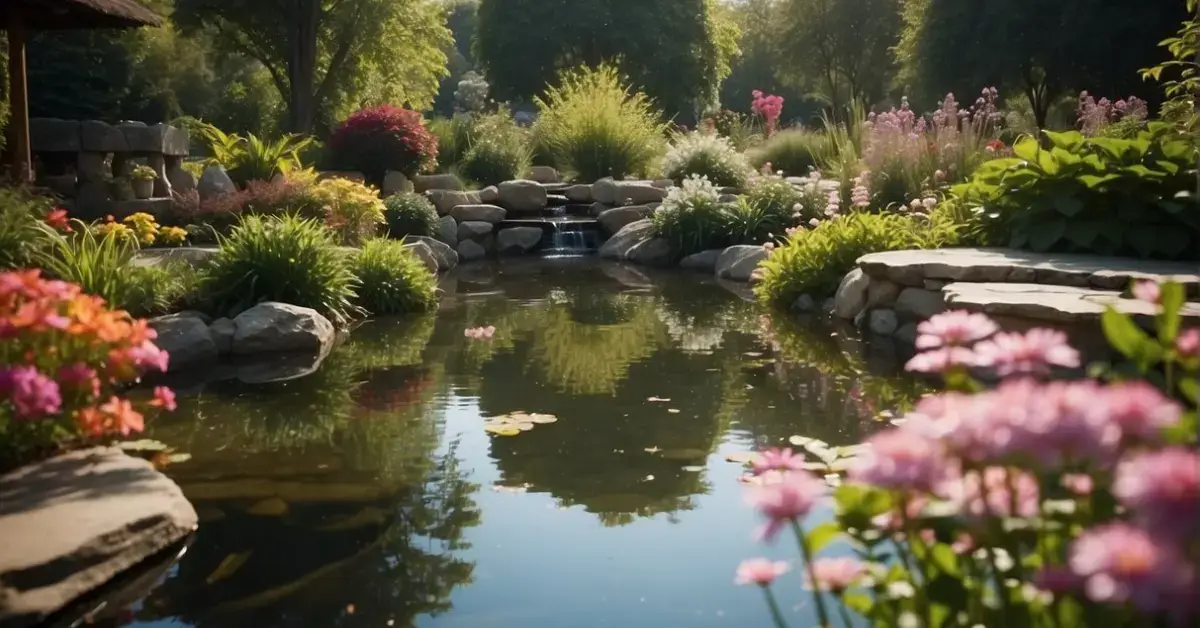Step into a sanctuary of serenity with a Spiritual Garden, where nature’s beauty intertwines with the sacred. From tranquil water features to vibrant blooms, explore how these gardens foster a deep connection to the divine, offering a space for reflection, meditation, and spiritual renewal amidst the lush greenery and harmonious surroundings.
Foundation of a Spiritual Garden
Creating a spiritual garden is a journey of aligning with the natural world and fostering a space of growth, both physically and spiritually. I see the earth as the ultimate canvas for this serene masterpiece, where every handful of soil enriches the foundation of my tranquil retreat.
I start by carefully selecting natural materials that resonate with the energy I wish to invite into my space. For me, organic gardening practices are non-negotiable, as they ensure that I’m nurturing my plants in harmony with nature.
Here’s how I lay the groundwork:
- Soil Preparation: I treat the soil as a sacred bed for my plants. I enrich it with compost to promote healthy growth.
- Intentional Planting: Each seed I plant carries an intention for growth and reflection, aligning with my spiritual goals.
- Incorporating Nature: I invite elements like rocks and water which I believe are grounding forces, enhancing the garden’s tranquility.
| Element | Significance |
|---|---|
| Soil | Earth’s nourishment |
| Seeds | Potential and Growth |
| Water Features | Flow and Reflection |
| Rocks & Crystals | Stability and Energy |
As I design my meditation garden, I ensure that there’s a cozy corner dedicated to introspection and peace. I intersperse the area with plants that I feel contribute to a spectrum of textures and scents, promoting a multisensory experience.
Ultimately, it’s the harmony between these elements that cultivates not only a flourishing garden but also a sanctuary for spiritual growth. With each visit, I feel a deeper sense of connection to the earth and a refreshed energy to carry with me.
Design and Elements of Serenity

Creating a spiritual garden is a labor of love, one that offers a sanctuary for both the body and soul. As I’ve curated my own garden, I’ve learned that each element is chosen with intention, fostering an atmosphere of peace and spiritual growth.
Plant Selection and Symbolism
In my spiritual garden, every plant holds meaning. I cherish the serene presence of a rose, symbolizing love and gratitude, and I nurture lavender and sage for their calming properties. Native plants are chosen not just for their beauty, but for their deeper connection to the land’s spirit.
Water Features and Stones
A bubbling fountain or a still water basin can be the heart of tranquility. I’ve placed smooth rocks at its edge to invite reflection. The water feature is more than decor; it’s a central point that promotes a calming energy flow, mirroring the stillness I seek within.
Spiritual Touches and Spaces
I dedicate corners of my garden for meditation cushions and benches, creating intentional spaces for spiritual practice. An altar adds a divine touch, providing a focal point for contemplation and a sense of connection to the divine.
Sacred and Symbolic Decor
The decor in my spiritual garden is carefully chosen. I’ve incorporated prayer flags and statues which act as symbols of my spiritual journey. Each item is placed to evoke strength, patience, and the transformative power of spirituality.
Nurturing Spiritual Connection
Gardening in this sacred space is a meditative act for me, fostering a deep spiritual connection. It’s not just about tending to plants, but nurturing the soil of my soul, allowing personal growth alongside that of my garden’s.
Wildlife and Ecosystem Harmony
I’ve designed my garden to welcome wildlife, embracing the joy and wonder that birds and other creatures bring. Their presence is a reminder of the delicate balance of our ecosystem, a living illustration of environmental care.
Seasonal Dynamics and Celebrations
I honor the cycles of nature, celebrating the resilience and renewal each season brings. From the first buds of spring to the dormancy of winter, each phase of the natural world offers a chance for reflection and celebration.
Community and Sharing Space
My spiritual garden is a place of community and hope. With seating areas for group meditation or reading, I’ve crafted a space where sharing and learning are nurtured, where the garden’s peace can radiate into the hearts of others.
Crafting Your Personal Sanctuary
Building my spiritual garden has been a dream come true; a personal sanctuary where I find peace and serenity. Custom touches like an intimate seating area have made it a unique refuge for spiritual retreat and self-discovery.
Holistic Practices and Activities
I integrate activities like yoga and tai chi into my garden. Spiritual practices amid nature’s beauty enhance well-being, acting as meditative movements that promote healing and recovery.
Healing and Therapeutic Benefits
This therapeutic space has been a source of recovery for me. A therapy garden where stress falls away and the process of gardening itself becomes a healing practice for the mind, body, and spirit.
Gardening for Personal and Spiritual Growth
Through gardening, I embark on a journey of personal and spiritual growth. It’s more than planting; it’s an experience that cultivates mindfulness, learning, and a deeper appreciation for the simple acts of nurturance.
Integration with Architectural Elements
Structural features like trellises or pathways serve both practical and spiritual roles in my garden. They guide movement and energy flow, complementing the natural forms and meditative spaces within the garden.
Sustainable Practices and Environmental Care
My commitment to sustainability is reflected in practices like composting and rainwater harvesting. Native plantings support pollinators and reinforce my garden’s role as a wildlife habitat, echoing a respect for nature’s intricacies.
Artistic Expression and Creativity
Art is a voice in my spiritual garden, speaking through sculptures and the interplay of colors and textures. These expressions of creativity spark wonder and joy, turning the garden into a canvas that reflects my inner visions.
Elements of Movement and Sound
The dance of bamboo in the wind or the melodious sounds of wind chimes enhances the multisensory experience of my garden. This layer of movement and sound deepens the spiritual essence and the feeling of connection with nature’s rhythms.
Adaptation for Various Climates
Integrating climate-adaptive plants means that the garden evolves and thrives throughout seasonal changes. Frost-resistant selections and shaded areas ensure the garden remains a sanctuary in all weather, resilient and evergreen as my spiritual journey.
Multisensory Experience and Exploration
Aromatic plants engage the senses, bringing scents to life, while tactile elements invite touch. The garden beckons to be explored with all senses, turning each visit into a new discovery.
Educational Components and Learning Opportunities
Educational signage and community programs transform my garden into a learning oasis. It’s a space where the curious come to learn about herbalism, ancient gardening techniques, and the natural world—an inspiring and enlightening environment for all.
Historical Influences and Traditions
I find beauty in connecting with the past, so I weave historical influences and cultural traditions into the fabric of my garden. Ancient symbols and references to spiritual figures thread a story through the garden’s paths, offering layers of depth and meaning.
Personal Reflection and Meditation Areas
Quiet corners with simple seating are engraved with personal stories, offering a place for solace and peace. These areas are key for my reflection, places where I can pause and soak in the serenity that my spiritual garden provides.
FAQ – Spiritual Garden

What does a garden represent spiritually?
A garden holds deep spiritual symbolism; it’s often seen as a reflection of the inner state of one’s soul. Elements like flowing water and vibrant plants are tools I use to foster a sense of peace and harmony with nature.
How do you make a spiritual garden?
To create a spiritual garden, I start by selecting a quiet location that feels serene. I incorporate elements that stimulate the senses, such as:
- Water Features: Like fountains or birdbaths for auditory calmness.
- Rocks and Crystals: To ground the space energetically.
- Plants with Meaning: Such as sage for cleansing or lavender for relaxation.
- Areas for Reflection: A bench or meditation circle for thought and introspection.
What does a flower bed mean spiritually?
Spiritually, a flower bed can symbolize growth and the continuous cycles of life. Each flower, from bud to bloom to withering, represents a phase in my personal journey, reminding me of the transient nature of life and the importance of finding beauty in each season.
If you liked this blog post about the topic: Spiritual Garden, don’t forget to leave me a comment down below to tell me about your experience with it. Or have a look at my other articles:
Feel free to also check out our other Articles from the category “Spiritual Garden“ and don’t forget to follow us on Pinterest.


